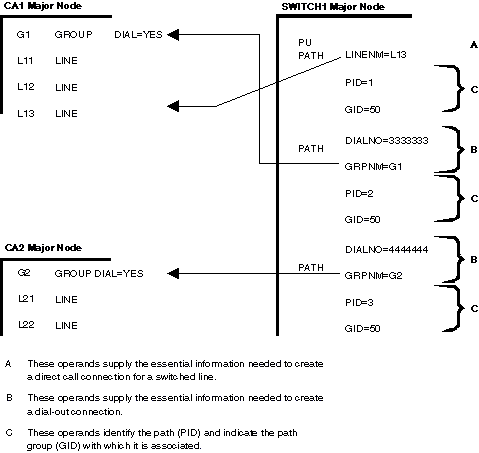 z/OS Communications Server: SNA Network Implementation Guide
z/OS Communications Server: SNA Network Implementation Guide
 z/OS Communications Server: SNA Network Implementation Guide
z/OS Communications Server: SNA Network Implementation Guide
|
Previous topic |
Next topic |
Contents |
Contact z/OS |
Library |
PDF
Controlling dial-out requests z/OS Communications Server: SNA Network Implementation Guide SC27-3672-01 |
|
|
If you want VTAM® to dial to a peripheral physical unit on a switched line, you need to give VTAM a path to contact the physical unit. You can identify the path using PATH definition statements. The PATH definition statement must be placed after the PU definition statement to define the paths over which that PU can be contacted. The PATH definition statement identifies to VTAM the line group and the dial characters to be used. Elements of a PATH are shown in Figure 1, parts A and B. Figure 1. Major elements of PATH definition statements
for switched major node
 VTAM searches the PATH definition statements for an available path in the order defined. If the line group contains more than one dial-out line, the first available line is tried. If contact cannot be established using that line group, VTAM tries again using the line group identified by the next PATH definition statement. If the line does not have automatic-call capability, the VTAM operator receives a message instructing the operator to manually dial the physical unit. Two operands on the PATH definition statement, PID and GID, are used to identify each path and to assemble the paths into groups of paths (Figure 1, part C). Both operands are used by the VTAM operator. The PID operand identifies the path with respect to its associated physical unit. (The PID is the equivalent of the PATH definition statement label.) By citing the physical unit name and the PID, the VTAM operator can make that specific path usable or not usable. The GID operand is used to associate the path with any other path or group of paths within the same switched major node. By naming the GID on the VARY PATH command, the VTAM operator can make that path and all similarly identified paths usable or not usable. The criteria used to assign paths to particular groups are entirely up to you. One possibility is to group paths according to the type of call indicated by the dialing digits (for example, internal [extension] calls, local calls, tie-line or Wide Area Telephone Service [WATS] calls, and long-distance calls). Dial-out operations for peripheral nodes (terminals) occur when a session is requested with a logical unit whose switched physical unit is not already connected to VTAM. 


|
 Copyright IBM Corporation 1990, 2014 Copyright IBM Corporation 1990, 2014 |